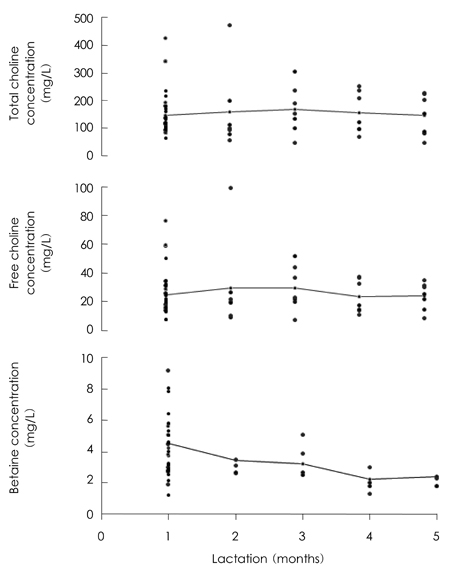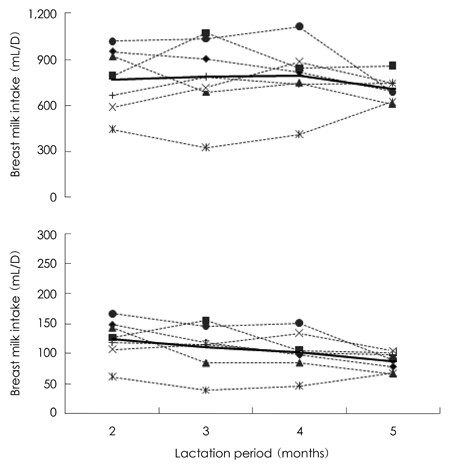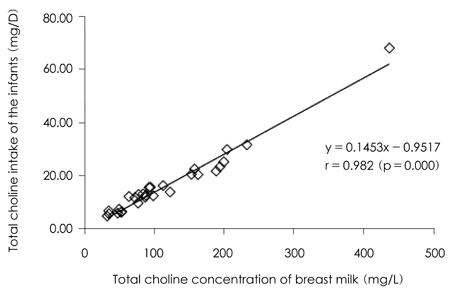Korean J Nutr.
2010 Dec;43(6):588-596. 10.4163/kjn.2010.43.6.588.
Choline and Betaine Concentrations in Breast Milk of Korean Lactating Women and the Choline and Betaine Intakes of Their Infants
- Affiliations
-
- 1Department of Food and Nutrition, College of Human Ecology, Chungnam National University, Daejeon 305-764, Korea. yjchung@cnu.ac.kr
- KMID: 2268055
- DOI: http://doi.org/10.4163/kjn.2010.43.6.588
Abstract
- Most nutrients taken by pregnant women are secreted into their breast milk. Food contains choline together with betaine, and in human body choline is oxidized to betaine which transfer methyl group. The aim of the study was to estimate the concentrations of choline and betaine in breast milk of Korean lactating women and the choline and betaine intakes of their infants. Total choline, free choline and betaine concentrations in breast milk of some lactating women living in Daejon Metropolitan city were analyzed every month by using HPLC-MS and enzymatic method during the first five months. Total choline concentrations of breast milks were 157.64 mg/L (1.52 mmol/L), 157.83 mg/L (1.52 mmol/L), 165.99 mg/L (1.60 mmol/L), 153.67 mg/L (1.48 mmol/L), 145.05 mg/L (1.39 mmol/L) by month after delivery for five months. The concentrations of total choline and free choline in breast milks were not significantly changed for the five months while the betaine concentrations gradually decreased. Daily intake of total choline of the infants appears to be adequate for the infant's requirement according to the US DRI; 124.6 mg/d, 120.9 mg/d, 126.5 mg/d 104.1 mg/d from 2nd to 5th month after birth. Free choline and betaine intakes of the infants were not significantly changed during the four months except showing decrease in betaine intake per kg body weight. Choline intakes of the infants more correlated with choline concentrations of the breast milks (r = 0.982, p = 0.000) than intake amount of the breast milk (r = 0.414, p = 0.028). These results suggest that the choline intake of Korean breast-fed infants appears to be adequate and the intake could be affected by the choline concentration of the breast milk.
Keyword
MeSH Terms
Figure
Reference
-
1. Meck WH, Smith RA, Wiliams CL. Organizational changes in cholinergic activity and enhanced visuospatial memory as a function of choline administered prenatally or postnatally or both. Behav Neurosci. 1989. 103(6):1234–1241.
Article2. Zeisel SH. Choline: an important nutrient in brain development, liver function and carcinogenesis. J Am Coll Nutr. 1992. 11(5):473–481.
Article3. Allen LH. B vitamins: Proposed fortification levels for complementary foods for young children. J Nutr. 2003. 133(9):3000S–3007S.
Article4. Lutter CK, Dewey KG. Proposed nutrient composition for fortified complementary foods. J Nutr. 2003. 133(9):3011S–3020S.
Article5. Lee YN, Moon J, Seol MY, Kim ES. The amount of the protein secretion of human milk and the protein intake of infant during breast-feeding. Korean J Nutr. 1995. 28(8):782–790.6. Kim ES, Kim JS, Cho KH. Taurine level in human milk and estimated intake of taurine by breast-fed infants during early period of lactation. Korean J Nutr. 1998. 31(3):363–368.7. Lim HS. Folate status in pregnant and lactating women. J Korean Soc Food Sci Nutr. 1997. 26(5):983–992.8. Lee JS, Kim ES. Study on vitamin A intake of breast-fed infants during the first 5 months of lactation. Korean J Nutr. 1998. 31(9):1433–1439.9. Kim ES. Vitamin A intake of exclusively breast-fed infants in Cheongju and Anseong areas. Korean J Nutr. 2003. 36(7):743–748.10. Kim ES, Kim SB, Lee DH. The yields of volume, thiamin and riboflavin from the milk of cesarian-section women, and their ingestion of infants. Korean J Nutr. 1999. 32(1):83–89.11. Keum HK, Kim ES. A longitudinal study on zinc secretion of lactating women and zinc intake of breast-fed infants. Korean J Nutr. 1999. 32(1):75–82.12. Institute of Medicine. Committee on Nutritional Status During Pregnancy and Lactation, Nutrition During Pregnancy. 1990. Washington DC: National Academy Press.13. Holm PI, Ueland PM, Kvalheim G, Lien EA. Determination of choline, betaine, and dimethylglycine in plasma by a high-throughput method based on normal-phase chromatography-tandem mass spectrometry. Clin Chem. 2003. 49(2):286–294.
Article14. Koc H, Mar MH, Ranasinghe A, Swenber JA, Zeisel SH. Quantitation of choline and its metabolites in tissues and foods by liquid chromatography/electrospray ionization-isoptope dilution mass spectrometry. Anal Chem. 2002. 74(18):4734–4740.
Article15. Woollard DC, Indyk HE. Determination of choline in milk and infant formulas by enzymatic analysis: collaborative study. J AOAC Int. 2000. 83(1):131–138.
Article16. Korean Pediatric Society. Physical growth of children in Korean. 1998.17. Institute of Medicine. Dietary Reference Intakes for Thiamin, Riboflavin, Niacin, Vitamin B6, Folate, Vitamin B12, Pantothenic Acid, Biotin and Choline. 2000. Washington, DC: National Academy Press.18. Woollard DC, Indyk HE. The routine, enzymatic estimation of total choline in milk and infant formulas. J Micronutr Anal. 1990. 7:1–14.19. Holmes-McNary MQ, Cheng WL, Mar MH, Fussell S, Zeisel SH. Choline and choline esters in human and rat milk and in infant formulas. Am J Clin Nutr. 1996. 64(4):572–576.
Article20. Holmes HC, Snodgrass GJ, Iles RA. Changes in the choline content of human breast milk in the first 3 weeks after birth. Eur J Pediatr. 2000. 159(3):198–204.
Article21. Maeda T, Okano C, Miyake A, Sawa J. Determination of choline in milk and dietary products by an enzymatic method. J Food Hyg Soc Jpn. 1993. 34(1):32–37.22. Ilcol YO, Ozbek R, Hamurtekin E, Ulus IH. Choline status in newborns, infants, children, breast-feeding women, breast-fed infants and human breast milk. J Nutr Biochem. 2005. 16(8):489–499.
Article23. Sakurai T, Furukawa M, Asoh M, Kanno T, Kojima T, Yonekubo A. Fat-soluble and water-soluble vitamin contents of breast milk from Japanese women. J Nutr Sci Vitaminol (Tokyo). 2005. 51(4):239–247.
Article24. Zeisel SH, Char D, Sheard NF. Choline, phosphatidylcholine and sphingomyelin in human and bovine milk and infant formulas. J Nutr. 1986. 116(1):50–58.
Article25. Fischer LM, da Costa KA, Galanko J, Sha W, Stephenson B, Vick J, Zeisel SH. Choline intake and genetic polymorphisms influence choline metabolite concentrations in human breast milk and plasma. Am J Clin Nutr. 2010. 92(2):336–346.
Article26. Sakamoto A, Ono H, Mizoguchi N, Sakura N. Betaine and homocysteine concentrations in infant formulae and breast milk. Pediatr Int. 2001. 43(6):637–640.
Article27. Zeisel SH, Mar MH, Howe JC, Holden JM. Concentrations of choline-containing compounds and betaine in common foods. J Nutr. 2003. 133(5):1302–1307.
Article28. Lee JA, Huh YR, Lee JI, Lim HS. Composition and yield of Korean breast milk and maternal intakes of foods and nutrients. Korean J Nutr. 1994. 27(8):795–804.29. Paul AA, Black AE, Evans J, Cole TJ, Whitehead RG. Breastmilk intake and growth in infants from two to ten months. J Hum Nutr Diet. 1988. 1(6):437–450.
Article30. Lee JS, Kim ES. Study on vitamin A intake of breast-fed infants during the first 5 months of lactation. Korean J Nutr. 1998. 31(9):1433–1439.
- Full Text Links
- Actions
-
Cited
- CITED
-
- Close
- Share
- Similar articles
-
- Choline intake and its dietary reference values in Korea and other countries: a review
- Folate Content of Human Milk During Extended Lactation and Folate Nutritional Status of Lactating Women in Korea
- Effects of aluminum on choline uptake and activities of choline acetyltransferase and acetylcholinesterase in rat brain
- Effects of Maternal Dietary Intakes and Health-Related Behaviors on Vitamin B Concentrations in Human Milk
- Genomic DNA Methylation Status and Plasma Homocysteine in Choline- and Folate-Deficient Rats





